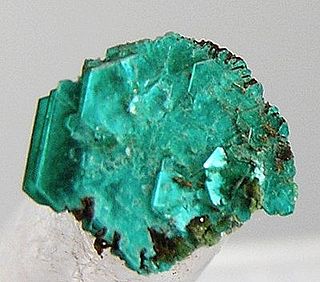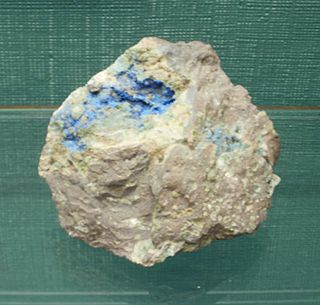
Chalcopyrite ( KAL-kə-PY-ryte, -koh-) is a copper iron sulfide mineral and the most abundant copper ore mineral. It has the chemical formula CuFeS2 and crystallizes in the tetragonal system. It has a brassy to golden yellow color and a hardness of 3.5 to 4 on the Mohs scale. Its streak is diagnostic as green tinged black.

Bornite, also known as peacock ore, is a sulfide mineral with chemical composition Cu5FeS4 that crystallizes in the orthorhombic system (pseudo-cubic).

Azurite is a soft, deep-blue copper mineral produced by weathering of copper ore deposits. During the early 19th century, it was also known as chessylite, after the type locality at Chessy-les-Mines near Lyon, France. The mineral, a basic carbonate with the chemical formula Cu3(CO3)2(OH)2, has been known since ancient times, and was mentioned in Pliny the Elder's Natural History under the Greek name kuanos (κυανός: "deep blue," root of English cyan) and the Latin name caeruleum. Since antiquity, azurite's exceptionally deep and clear blue has been associated with low-humidity desert and winter skies. The modern English name of the mineral reflects this association, since both azurite and azure are derived via Arabic from the Persian lazhward (لاژورد), an area known for its deposits of another deep-blue stone, lapis lazuli ("stone of azure").

Cuprite is an oxide mineral composed of copper(I) oxide Cu2O, and is a minor ore of copper.

Dioptase is an intense emerald-green to bluish-green copper cyclosilicate mineral. It is transparent to translucent. Its luster is vitreous to sub-adamantine. Its formula is Cu6Si6O18·6H2O (also reported as CuSiO2(OH)2). It has a hardness of 5, the same as tooth enamel. Its specific gravity is 3.28–3.35, and it has two perfect and one very good cleavage directions. Additionally, dioptase is very fragile, and specimens must be handled with great care. It is a trigonal mineral, forming 6-sided crystals that are terminated by rhombohedra.

Murdochite is a mineral combining lead and copper oxides with the chemical formula PbCu
6O
8−x(Cl,Br)
2x (x ≤ 0.5).

Copper(II) oxide or cupric oxide is an inorganic compound with the formula CuO. A black solid, it is one of the two stable oxides of copper, the other being Cu2O or copper(I) oxide (cuprous oxide). As a mineral, it is known as tenorite. It is a product of copper mining and the precursor to many other copper-containing products and chemical compounds.

Tenorite is a copper oxide mineral with the chemical formula CuO.

Ajoite is a hydrated sodium potassium copper aluminium silicate hydroxide mineral. Ajoite has the chemical formula (Na,K)Cu7AlSi9O24(OH)6·3H2O, and minor Mn, Fe and Ca are usually also present in the structure. Ajoite is used as a minor ore of copper.

Arthurite is a mineral composed of divalent copper and iron ions in combination with trivalent arsenate, phosphate and sulfate ions with hydrogen and oxygen. Initially discovered by Sir Arthur Russell in 1954 at Hingston Down Consols mine in Calstock, Cornwall, England, arthurite is formed as a resultant mineral in the oxidation region of some copper deposits by the variation of enargite or arsenopyrite. The chemical formula of Arthurite is CuFe23+(AsO4,PO4,SO4)2(O,OH)2•4H2O.

Chalcophyllite is a rare secondary copper arsenate mineral occurring in the oxidized zones of some arsenic-bearing copper deposits. It was first described from material collected in Germany. At one time chalcophyllite from Wheal Tamar in Cornwall, England, was called tamarite, but this name is now discredited. At Wheal Gorland a specimen exhibiting partial replacement of liriconite, Cu
2Al(AsO
4)(OH)
4•(4H
2O), by chalcophyllite has been found. The mineral is named from the Greek, chalco "copper" and fyllon, "leaf", in allusion to its composition and platy structure. It is a classic Cornish mineral that can be confused with tabular spangolite.

Calumetite is a natural rarely occurring mineral. It was discovered in 1963 at the Centennial Mine near Calumet, Michigan, United States. Calumetite was first discovered along with anthonyite. It has a chemical formula of Cu(OH,Cl)
2•2(H
2O).

Pseudomalachite is a phosphate of copper with hydroxyl, named from the Greek for “false” and “malachite”, because of its similarity in appearance to the carbonate mineral malachite, Cu2(CO3)(OH)2. Both are green coloured secondary minerals found in oxidised zones of copper deposits, often associated with each other. Pseudomalachite is polymorphous with reichenbachite and ludjibaite. It was discovered in 1813. Prior to 1950 it was thought that dihydrite, lunnite, ehlite, tagilite and prasin were separate mineral species, but Berry analysed specimens labelled with these names from several museums, and found that they were in fact pseudomalachite. The old names are no longer recognised by the IMA.

Anthonyite is a hydrous secondary copper halide mineral with chemical formula of Cu(OH,Cl)2•3(H2O).

Plancheite is a hydrated copper silicate mineral with the formula Cu8Si8O22(OH)4•(H2O). It is closely related to shattuckite in structure and appearance, and the two minerals are often confused.

Cornubite is a rare secondary copper arsenate mineral with formula: Cu5(AsO4)2(OH)4. It was first described for its discovery in 1958 in Wheal Carpenter, Gwinear, Cornwall, England, UK. The name is from Cornubia, the medieval Latin name for Cornwall. It is a dimorph of Cornwallite, and the arsenic analogue of pseudomalachite.

Diaboleite is a blue-colored mineral with formula Pb2CuCl2(OH)4. It was discovered in England in 1923 and named diaboleite, from the Greek word διά and boleite, meaning "distinct from boleite". The mineral has since been found in a number of countries.

Marshite (CuI) is a naturally occurring isometric halide mineral with occasional silver (Ag) substitution for copper (Cu). Solid solution between the silver end-member miersite and the copper end-member marshite has been found in these minerals from deposits in Broken Hill, Australia. The mineral's name is derived from the person who first described it, an Australian mineral collector named Charles W. Marsh. Marsh drew attention to native copper iodide (Marshite) in the 1800s emphasizing its natural occurrence, it is not to be confused with copper (I) iodide a substance commonly synthesized in laboratory settings.

Chalconatronite is a carbonate mineral and rare secondary copper mineral that contains copper, sodium, carbon, oxygen, and hydrogen, its chemical formula is Na2Cu(CO3)2•3(H2O). Chalconatronite is partially soluble in water, and only decomposes, although chalconatronite is soluble while cold, in dilute acids. The name comes from the mineral's compounds, copper ("chalcos" in Greek) and natron, naturally forming sodium carbonate. The mineral is thought to be formed by water carrying alkali carbonates (possibly from soil) reacting with bronze. Similar minerals include malachite, azurite, and other copper carbonates. Chalconatronite has also been found and recorded in Australia, Germany, and Colorado.
Euchlorine (KNaCu3(SO4)3O) is a rare emerald-green colored sulfate mineral found naturally occurring as a sublimate in fumaroles around volcanic eruptions. It was first discovered in fumaroles of the 1868 eruption at Mount Vesuvius in Campania, Italy by Arcangelo Scacchi. The name 'euchlorine' comes from the Greek word εΰχλωρος meaning "pale green" in reference to the mineral's color, other reported spellings include euclorina, euchlorin, and euchlorite.





















